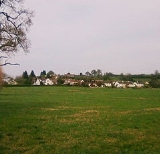
Horrington
Encyclopedia
Horrington is a collection of three small villages (South Horrington, East Horrington and West Horrington) in the parish of St Cuthbert Out
1 miles (2 km) or 2 miles (3 km) east of Wells
, Somerset
, England.
South Horrington is a relatively new village created in the late 1990s from the defunct Mendip Hospital that was closed in 1991.
The original hospital opened on 1 March 1848 and was built to house 400 patients and staff. The principal architect was George Gilbert Scott
, who is better known for his designs of St Pancras Station
and the Albert Memorial
in London.
His work has largely been retained and the main buildings have been converted into a range of flats and houses. Newer houses have been built on the original kitchen garden
s and orchards although the front grounds remain largely unaltered.
The nearby Maesbury Railway Cutting
of the Somerset and Dorset Joint Railway
exposes approximately 135 metres of strata representing the middle and upper Lower Limestone
Shales
and the basal Black Rock Limestone. Both formations are of early Carboniferous
(Courceyan) age.
William Catcott, born 27 Feb 1808 in West Horrington was known as the Baker Poet. He had a book of his poems called "Morning Musings" published which was about the local Mendip Hills and his family. He became a baker in Wells, Somerset and died on 13 Nov 1870. The local paper carried an obituary.
St Cuthbert Out
St Cuthbert Out, sometimes Wells St Cuthbert Out is a civil parish in the Mendip district of Somerset, England. It entirely surrounds the city and parish of Wells. According to the 2001 census it had a population of 3,459. The parish is crossed by the Monarch's Way long distance footpath.The...
1 miles (2 km) or 2 miles (3 km) east of Wells
Wells
Wells is a cathedral city and civil parish in the Mendip district of Somerset, England, on the southern edge of the Mendip Hills. Although the population recorded in the 2001 census is 10,406, it has had city status since 1205...
, Somerset
Somerset
The ceremonial and non-metropolitan county of Somerset in South West England borders Bristol and Gloucestershire to the north, Wiltshire to the east, Dorset to the south-east, and Devon to the south-west. It is partly bounded to the north and west by the Bristol Channel and the estuary of the...
, England.
South Horrington is a relatively new village created in the late 1990s from the defunct Mendip Hospital that was closed in 1991.
The original hospital opened on 1 March 1848 and was built to house 400 patients and staff. The principal architect was George Gilbert Scott
George Gilbert Scott
Sir George Gilbert Scott was an English architect of the Victorian Age, chiefly associated with the design, building and renovation of churches, cathedrals and workhouses...
, who is better known for his designs of St Pancras Station
St Pancras railway station
St Pancras railway station, also known as London St Pancras and since 2007 as St Pancras International, is a central London railway terminus celebrated for its Victorian architecture. The Grade I listed building stands on Euston Road in St Pancras, London Borough of Camden, between the...
and the Albert Memorial
Albert Memorial
The Albert Memorial is situated in Kensington Gardens, London, England, directly to the north of the Royal Albert Hall. It was commissioned by Queen Victoria in memory of her beloved husband, Prince Albert who died of typhoid in 1861. The memorial was designed by Sir George Gilbert Scott in the...
in London.
His work has largely been retained and the main buildings have been converted into a range of flats and houses. Newer houses have been built on the original kitchen garden
Kitchen garden
The traditional kitchen garden, also known as a potager, is a space separate from the rest of the residential garden - the ornamental plants and lawn areas...
s and orchards although the front grounds remain largely unaltered.
The nearby Maesbury Railway Cutting
Maesbury Railway Cutting
Maesbury Railway Cutting is a 2 hectare geological Site of Special Scientific Interest between East Horrington and Gurney Slade in Somerset, notified in 1995.It was part of the Somerset and Dorset Joint Railway....
of the Somerset and Dorset Joint Railway
Somerset and Dorset Joint Railway
The Somerset & Dorset Joint Railway – almost always referred to as "the S&D" – was an English railway line connecting Bath in north east Somerset and Bournemouth now in south east Dorset but then in Hampshire...
exposes approximately 135 metres of strata representing the middle and upper Lower Limestone
Limestone
Limestone is a sedimentary rock composed largely of the minerals calcite and aragonite, which are different crystal forms of calcium carbonate . Many limestones are composed from skeletal fragments of marine organisms such as coral or foraminifera....
Shales
Shalës
Shalës is a municipality in the Elbasan District, Elbasan County, central Albania. The municipality consists of the villages Shalës, Licaj, Kurtalli, Xibrake, Xherie and Kodras....
and the basal Black Rock Limestone. Both formations are of early Carboniferous
Carboniferous
The Carboniferous is a geologic period and system that extends from the end of the Devonian Period, about 359.2 ± 2.5 Mya , to the beginning of the Permian Period, about 299.0 ± 0.8 Mya . The name is derived from the Latin word for coal, carbo. Carboniferous means "coal-bearing"...
(Courceyan) age.
William Catcott, born 27 Feb 1808 in West Horrington was known as the Baker Poet. He had a book of his poems called "Morning Musings" published which was about the local Mendip Hills and his family. He became a baker in Wells, Somerset and died on 13 Nov 1870. The local paper carried an obituary.

